Small Home Gazette, Fall 2011
Addressing Tile Damage
A Conversation with Tile Setter Jan Hohn

Many bungalows have tile installations, either original to the home or more recently done. Bathrooms are perhaps the most common location for tiles, though they also are found in fireplace surrounds, entryway floors and kitchens.
While tiles are tough, they can be damaged. Most people just live with the damage or replace the installation completely. But some damage can be repaired, or at least, disguised.
We recently spoke to Jan Hohn, owner of Hohn & Hohn, Inc., in St. Paul. Jan has been repairing vintage tiles and installing new tiles in old homes for many years. She agreed to share a few trade secrets with us.
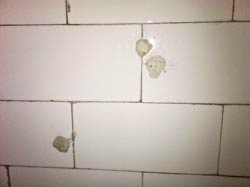 Small Home Gazette: Original tile in many old homes has become damaged over the years. A common problem is to have holes in the tile wainscot near bathroom sinks where toothbrush holders, cup holders, or towel bars have broken off or have been removed.
Small Home Gazette: Original tile in many old homes has become damaged over the years. A common problem is to have holes in the tile wainscot near bathroom sinks where toothbrush holders, cup holders, or towel bars have broken off or have been removed.
Jan Hohn: Yes, and another place you’ll find damaged wall tiles is above the toilet tank. Old toilets had wall-mounted tanks. The newer toilets are shorter, so of course you can see the holes in the wall above the tank.
SHG: Is there any way to repair such scars, or at least make them less obvious?
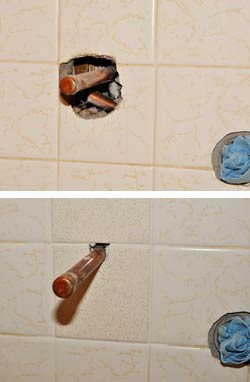
Before and after shots of replaced wall tiles. Note the replacement tile is above and below the copper water supply pipe and is a close match to the existing tile.
Hohn: Any time you’ve got holes in tiles, there are two options. First, you can try to remove the individual tile and replace it. But vintage replacement tiles are not easy to come by. Architectural salvage businesses may have some. Locally, both North Prairie Tiles and Clay Squared to Infinity have made tiles for me to replace tiles in old walls. I take the tile out and have them do a color match; then they make a new tile, which I install. Hopefully it blends well enough that it isn’t seen.
However, that is not a cheap way to go. Trying to surgically remove one tile is not easy. And the color match is a few hundred dollars, so that route is an expensive repair. Depending on how many tiles you’re talking about, it could be upwards of $800 to $1,000. That’s cost prohibitive for a lot of people.
SHG: And the other option?
Hohn: Another way I have dealt with holes is to fill them and paint them. I first fill them with some sanded grout (that is, grout with sand in it), then put an unsanded grout (grout with no sand) on the top, and allow it to set. Unsanded grout is smooth and can be sanded with very fine-grit sandpaper to even the surface.
Then I have several tubes of artist’s acrylic paints, which you can buy at an art store. I use a little palette, mix the paints to do a color match, and paint the area of the tile that’s damaged. I try to blend it so that your eye doesn’t catch it when you walk in the room. Most people will go for that kind of repair.
SHG: How durable is it?
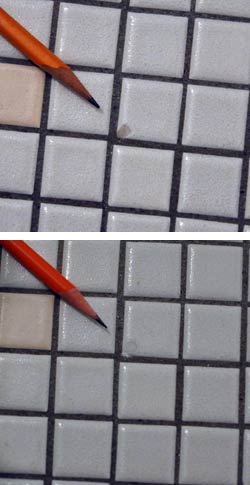
Before and after shots of chipped floor tile repaired with acrylic paint.
Hohn: It’s actually quite durable. Most of these repairs are on the wall, and you don’t have a lot of water hitting it, either behind the toilet or even by the sink. I’ve also used acrylic paints on floor tiles. For example, to repair holes made for the pegs that were on the bottom of old chrome sink legs.
SHG: Where do you find the paints?
Hohn: There’s a paint store on Grand Avenue in St. Paul called Wet Paint. It’s an artist’s supply store, and they have tubes of acrylic paint in a variety of colors. People would only have to buy one, two or three colors to mix to match their tile color. If you can, bring in a sample of the tile or even a photo of it. The people at Wet Paint are very helpful in choosing the right colors.
SHG: How much does the fill-and-paint type of repair cost?
Hohn: If I were to do it, it probably would be $100 to $200, depending on how much time was involved and how big the holes were and how many there were. It’s something
homeowners could do themselves. If you mess it up, you just sand the paint off and try it again. One thing people need to understand—it’s not perfect. But you can get it to the point where your eye doesn’t catch it. There’s one of my trade secrets, right there! A lot of tile guys out there aren’t going to want to do that. I’m very happy to do it, because I think it’s wonderful if we can save some of these old tiles and bathrooms.
(Editor’s note: We found a YouTube video that demonstrates a similar technique: www.youtube.com/watch?v=CxRB_9NRbyc)
SHG: What about cracked tiles?
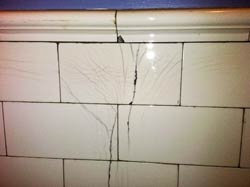 Hohn: I use the same repair method. Sometimes filling the cracks with unsanded grout and then painting them works. I’d recommend against using caulk. Caulk may help to hold the tiles together, but the grout can do the same thing and grout is paintable.
Hohn: I use the same repair method. Sometimes filling the cracks with unsanded grout and then painting them works. I’d recommend against using caulk. Caulk may help to hold the tiles together, but the grout can do the same thing and grout is paintable.
SHG: What about taking tiles from one place in a bathroom—a place where they aren’t seen, like behind the sink or a cabinet—and using those to replace damaged tiles that are in a more visible location?
Hohn: Yes, that’s certainly possible to do. The only thing to remember is that harvesting tiles is not easy. You usually have to destroy a large area to get a few tiles—or even one tile. If you’re going to harvest one tile, you have to destroy all the tiles around that one tile to get it out. You have to cut through the cement mud bed, through the wire lath, down to the studs, and pull out the whole chunk. Then you have to slice the tile off of the mud with a saw. It’s a time consuming job and very intrusive.
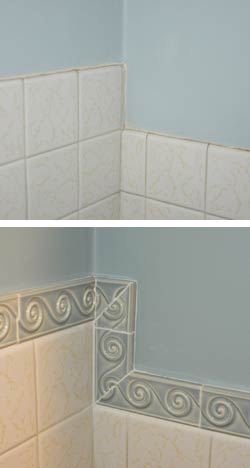
Before and after shots of a band of 2″ x 6″ tiles added above existing wall tiles.
SHG: What about adding decorative trim pieces to an old tile installation? A Bungalow Club member wanted to know if it would be possible to add a decorative cap on top of field tile, or insert a decorative band around the perimeter, within the field tile.
Hohn: I just did a project where the homeowner wanted to do exactly that. She had an all white bathroom and wanted to put some color in it. She ended up finding some multi-color glass tile, mini-rectangles, 5/8 inch by 1 1/4 inches. I put three rows of the glass tiles right above the bullnose. I didn’t even take out the bullnose; we just put it right above the older tile and made the grout joint as narrow as we could. She loved it.
It’s also possible to remove the top bullnose or mud cap row of tiles and put a decorative strip of tile in there and then put another cap on top. Those kinds of jobs could go anywhere from $400 or $500 and up. It takes time to cut tiles out and to be neat about it. But it’s less expensive than doing a whole new bathroom.
If you’re looking at putting really nice subway ceramic tile wainscot in, which retails for 20-some dollars a square foot, you’re talking $6,000 to $8,000 for just the tile without the labor. On the other hand, you’d spend maybe $1,000 to $1,500 to add a decorative tile strip and maybe a cap. That’s a whole lot less than a new bathroom. These things are possible; it just takes a little time. I kind of enjoy doing things like that.
SHG: If someone has a vintage bathroom and some tile grout is missing or badly stained, what can be done?
Hohn: If you’ve got missing grout you want to replace, I try to clean the original grout really well first so that the color I’m trying to match is more accurate. I’ve got grout boxes from 10 different companies. Each company’s grout colors are a little different. It’s amazing how many colors are out there. Usually I can find one that’s pretty close.
SHG: How do you clean dirty grout?
Hohn: I have some really good grout cleaners that may be only available at distributors. The ones that I use are TEC brand at Rubble Tile, in Minnetonka. Use an acid-based cleaner such as TEC Like New to clean efflorescence, and one that’s alkali based, such as TEC Superclean, to clean soap scum. Many times you need to use both to clean grout. The old subway tile grout joints were originally white, but they’ve aged over time, and they’ve become more gray.
SHG: And what about cleaning the tiles themselves? Will any standard bathroom cleaner do?
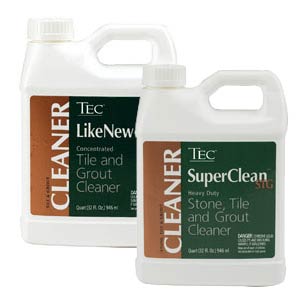 Hohn: The products I just mentioned for grout cleaning will also clean tile. TEC also has a cleaner called Refresh Pro that can be used as a “daily” cleaner. This cleaner not only cleans but it puts down a little sealer so it makes cleaning easier the next time. The companies Aqua Mix and Miracle also have cleaning products that are quite good.
Hohn: The products I just mentioned for grout cleaning will also clean tile. TEC also has a cleaner called Refresh Pro that can be used as a “daily” cleaner. This cleaner not only cleans but it puts down a little sealer so it makes cleaning easier the next time. The companies Aqua Mix and Miracle also have cleaning products that are quite good.
The only standard cleaner I would buy is CLR (Calcium, Lime & Rust remover, in a green bottle). But one needs to be careful with CLR because it is quite caustic. Other tile cleaners available at places like Target or Walmart don’t have the cleaning power that TEC, Aqua Mix, or Miracle products have. And some of them actually promote mildew, so one always needs to buy more of the product to keep tile clean.
Finally, one of the best ways to keep a shower or tub surround clean is to squeegee the walls down after each use. It only takes about 30 seconds, and the tile stays cleaner much longer.
SHG: When you’re installing new tile, what color of grout do you recommend?
Hohn: Unless the homeowner really, really wants white, I would recommend something off-white. To me a light gray is really nice. I don’t like the really dark gray grouts in subway tiles, because that’s not really right either. There are some nice colors out there called Silverado, Oyster Gray or Silver Bullet. They show the definition of the tile yet they’re not overpowering. Some people think gray is going to look dirty all the time. Well, no, not really. It also depends on how big the grout joints are. One-eighth inch is really wide, too wide. Usually subway tiles are set with a 1/16- to 3/32-inch joint.
SHG: What else would you like our readers to know?
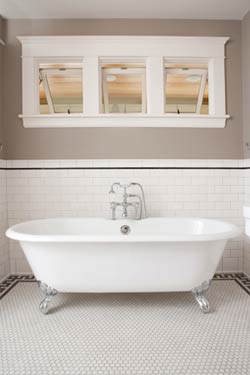 Hohn: I’d like people to be aware that there are companies out there that are making tiles that can be used in these bathrooms again. I remember 20 years ago when I started, you could hardly find anything in the old styles. Now there are a few sources, which is great.
Hohn: I’d like people to be aware that there are companies out there that are making tiles that can be used in these bathrooms again. I remember 20 years ago when I started, you could hardly find anything in the old styles. Now there are a few sources, which is great.
There’s American Restoration Tile—Clay Squared to Infinity carries their line. They make all the mosaic tiles for floors. There are also manufacturers that make the old style radius bullnose (mud cap) and ½-by-6-inch decorative tiles that look nice just under the mud cap.
I’m involved in a project on a church manse in St. Paul. The front porch floor needs to be repaired. The entire floor is 1-inch red hexagonal tile with a border of greens and whites. I’m going to send sample tiles to American Restoration Tile for them to match. That’s something people don’t know about. There is also Subway Ceramics. Even a lot of tile contractors don’t know these companies are out there. One needs to search a bit to find a contractor who knows what’s out there in the tile world.
Resources:
Hohn & Hohn, Inc.
Jan Hohn, owner
651-224-8877
hohn.hohn@comcast.net
www.hohnandhohntile.com
Clay Squared to Infinity
Josh Blanc, co-owner
612-781-6409
josh@claysquared.com
www.claysquared.com
Historic tiles page: http://www.claysquared.com/index.php/ceramic-tiles/category/C7
North Prairie Tileworks
612-871-3421
www.handmadetile.com
Rubble Tile
952-938-2599
info@rubbletile.com
www.rubbletile.com











